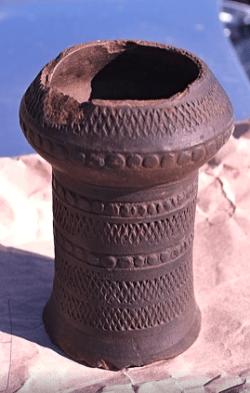Krásný pohár.
Díky za takové články! 
16 May 2016 Rare Gothic Cup
Categories: Calendar
 A big surprise awaited the archaeologists who have been exploring the archaeological site of Zámčiško above the town of Poprad for a long time. They discovered a rare Gothic cup. The archaeologists expected to come across rarer artefacts. But they were literally blown away by the cup.
A big surprise awaited the archaeologists who have been exploring the archaeological site of Zámčiško above the town of Poprad for a long time. They discovered a rare Gothic cup. The archaeologists expected to come across rarer artefacts. But they were literally blown away by the cup.
According to archaeologists, such cups are rarely well decorated. "It's probably an import from a more advanced pottery, perhaps from the Rhineland," Marián Soják from the Institute of Archaeology of the Slovak Academy of Sciences in Spišská Nová Ves commented on the discovery at the time.
In addition to medieval finds from around the fifteenth century, archaeologists have also found objects from prehistoric times under the Tatras. The site is located at an altitude of 921 metres and was inhabited in various periods, as evidenced by the finds themselves.
In the Middle Ages - roughly in the 13th and 15th centuries - the older fortifications were extended to include the north-western forecourt. This created a larger-scale fortress. "There were probably fraternal armies there. We have written records of them. For example, the nearby village of Spišská Teplica was burnt down by the Hussites in 1433 and then by the Brothers' troops in the 15th century," Soják recalled.
The so-called Brothers were members of military units composed of former Hussite fighters. The units operated independently in Slovakia, Moravia, northern Austria and southern Poland, where they brought the ideas of Hussitism between 1445 and 1467.
The fortress was strategically located. It was used to guard the road from the Poprad basin to the territory of the Gemer region. In addition to the medieval cup, archaeologists have also found other medieval finds in this locality. These include iron spurs, which are proof that there were armies in this area. There are also objects that were used in agriculture.
"The prehistoric period is also represented. However, we don't know exactly whether it is younger or later Stone Age or Bronze Age. We have a few pieces of stone chipped obsidian from which tools were made. They served the function of today's knives, scissors, drills, files, chisels and so on. We hope to find pottery to go with it in the future so that we can better time the finds," Soják said.
The finds have been professionally treated by experts in a laboratory in Nitra. The archaeologists then counted on them being part of the exhibition...
Sources: www.sme.sk, www.noviny.sk
The article is included in categories:



